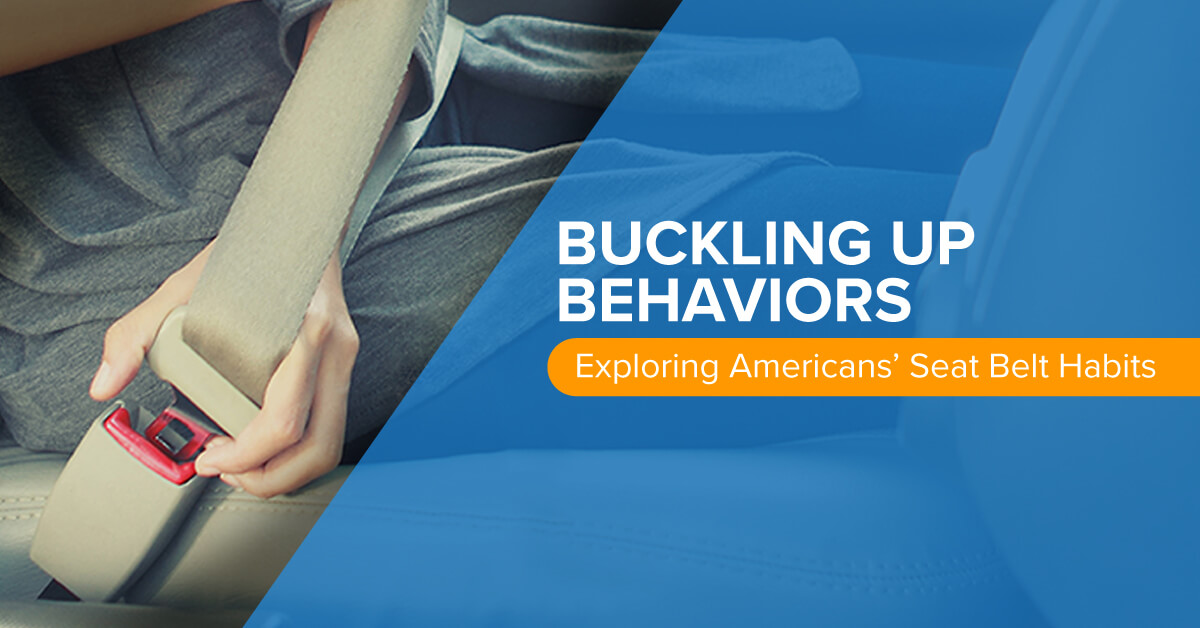
Automotive safety technology has changed rapidly in recent years, with new and impressive features altering our expectations of protection on the road. From advanced safety system features such as blind spot detection to new autonomous driving capabilities, a range of guards against human error may be making us safer drivers – or at least defending us from those who aren't.
However, the most powerful car safety device at our disposal may be so humble that we often ignore it: the seat belt.
According to the Centers for Disease Control's fatal crash statistics, these familiar restraints cut crash-related injuries and deaths by roughly half, saving about 14,000 lives a year. Simple and effective, seat belts prompt only one question: Why do some of us fail to use them?
In this project, we surveyed 1,000 Americans of various demographics to learn how consistently they buckled up, and which groups still resisted the seat belt's safety appeal. Our findings reveal seat belt usage varies significantly, leavinfog many drivers vulnerable to deadly outcomes in a crash.
Read on to learn how your seat belt habits compare to that of other drivers on the road.
Buckling Up, by Generation
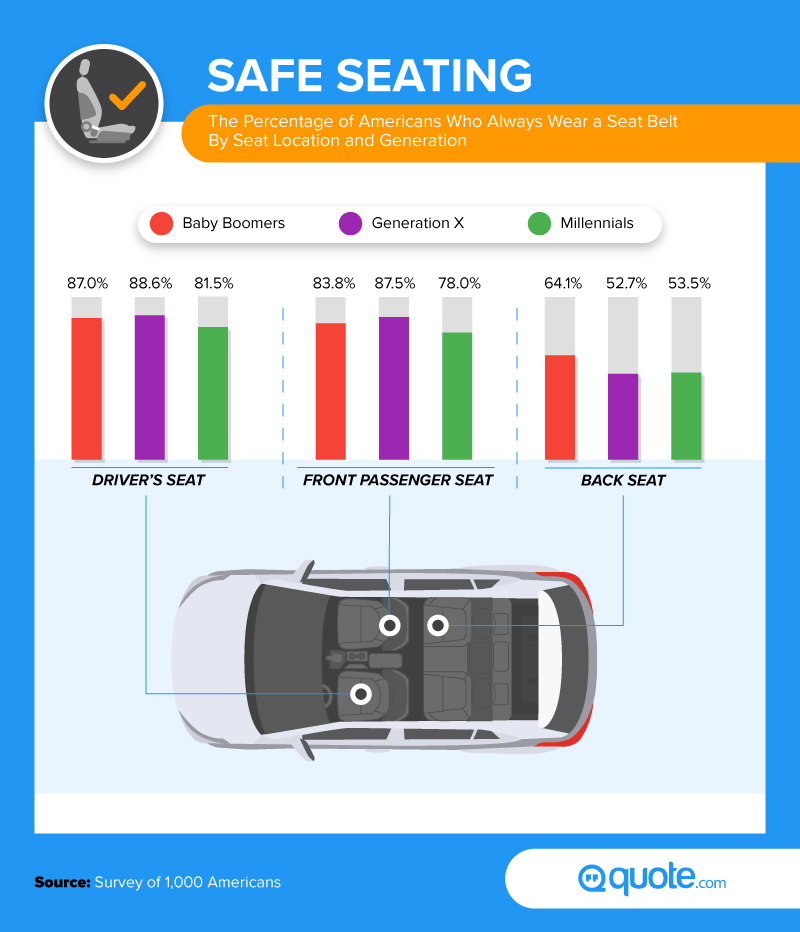
To analyze the seat belt habits of Americans by age group, we split our respondents into three distinct generations by birth year.
- Baby Boomers: born 1946–1964
- Generation X: born 1965–1980
- Millennials: born 1981–1997
Our results reveal an encouraging trend: The majority of every generation buckled up every time, no matter where they sat in the car.
Seat belt use was particularly strong in the driver's seat, where more than 4 in 5 members of every generation always used a seat belt. The front passenger seat saw slightly lower numbers, although an overwhelming majority still used seat belts on every occasion.
In these front seats, Gen Xers were most consistent, followed closely by baby boomers and millennials. While recently licensed teenage drivers have notoriously low rates of seat belt use, it seems we're still relatively insensitive about safety in our 20s.
But in the back seats, more troubling findings emerged. Only slightly more than half of Gen Xers and millennials buckled up whenever riding in the back, and baby boomers did so just 64 percent of the time.
Perhaps these results relate to recent research regarding backseat safety habits, which found people were less likely to use seat belts in hired cars, such as taxis or ride-sharing vehicles. However, no matter who's driving, rear passengers without seat belts are at risk of sustaining injuries as well, especially if they're thrown from the car as human projectiles.
Buckling Up, by Gender
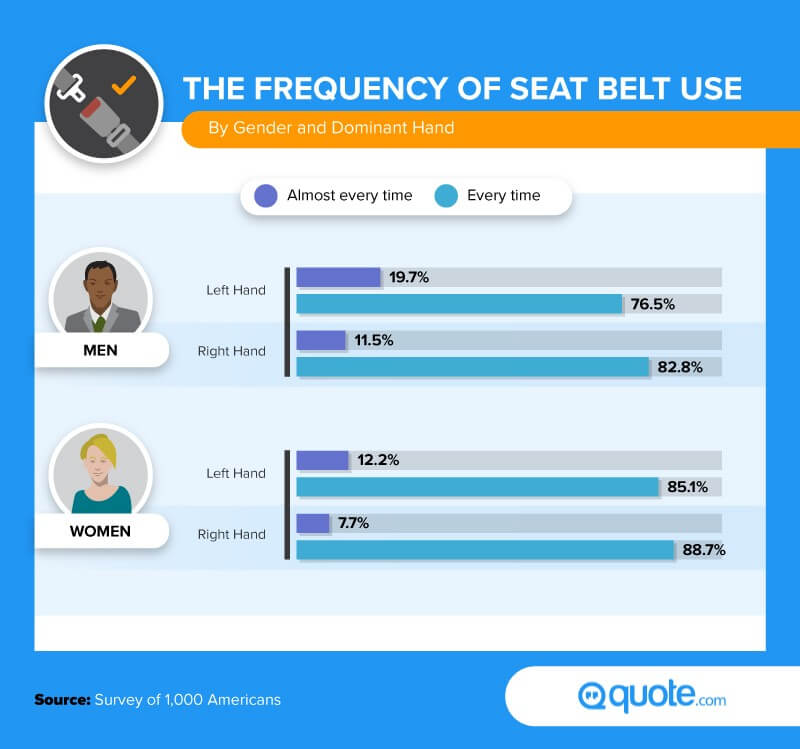
When it came to comparing genders, women were more likely than men to buckle up every time.
Perhaps that's one reason insurers' secretive pricing algorithms tend to generate higher premiums for men. While this finding may not surprise those who believe men are more reckless in all matters automotive, we also found righties had a better record of seat belt use than their left-handed counterparts. This held true for both men and women, which leads us to wonder why this is the case.
Perhaps car manufacturers cater to the majority when designing their vehicle interiors, making the experience of putting your seat belt in place more uncomfortable for left-handed drivers and passengers. Or maybe lefties find driving one-handed more difficult because the seat belt crosses over their dominant shoulder.
Whatever the reason, minor discomfort is certainly worth the added protection a seat belt provides.
The Geography of Seat Belt Safety
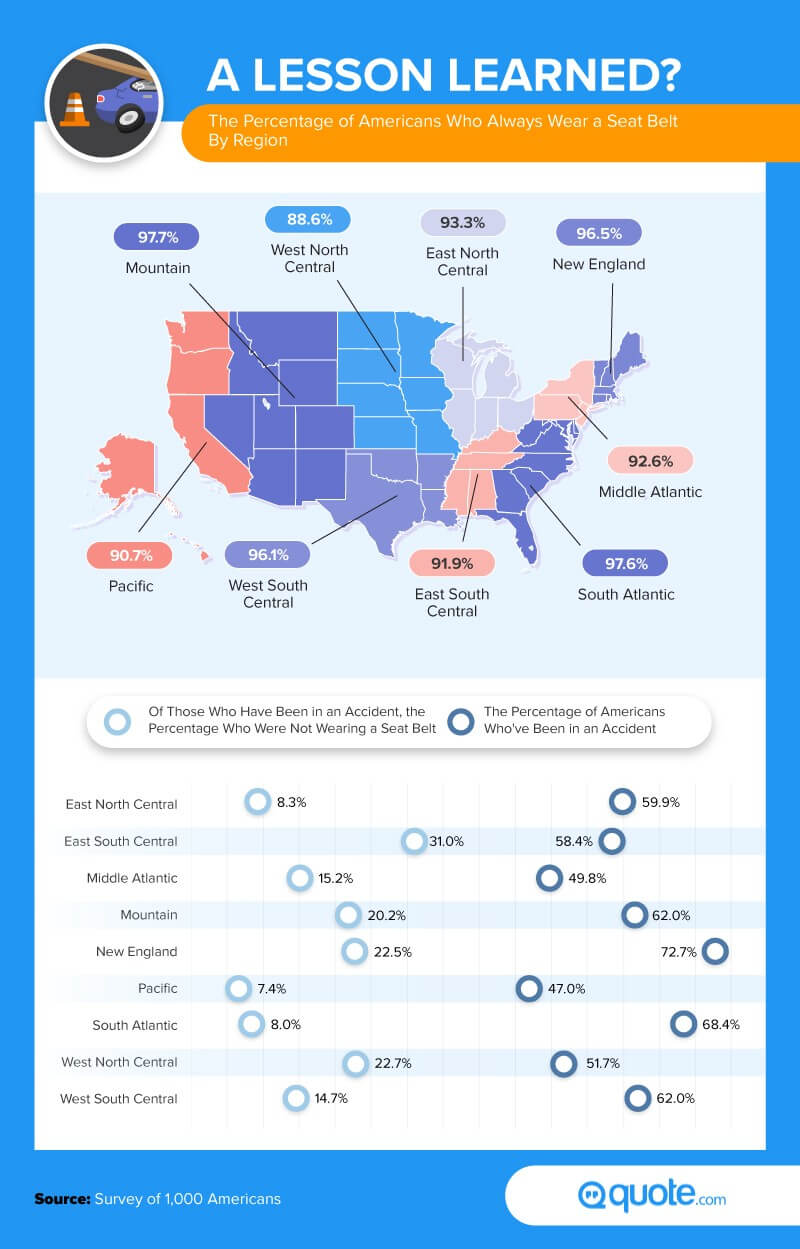
Geographically speaking, much of the country boasted excellent rates of seat belt use among drivers.
In the South Atlantic, Mountain, West South Central, and New England regions, more than 96 percent of drivers always buckled up when behind the wheel. But there were also some regions with relatively low rates of seat belt use, such as the West North Central areas.
Turning to our participants' accident histories, we studied the percentage of drivers in each region that had been in an accident and how many were not wearing seat belts at the time. While New England and the South Atlantic regions were most accident-prone overall, the East South Central region had the highest percentage of those involved in an accident when not wearing a seatbelt. Many states in that region, such as Alabama, have significant rural populations in which the CDC has identified low rates of seatbelt use.
Seat Belt Use, by Make
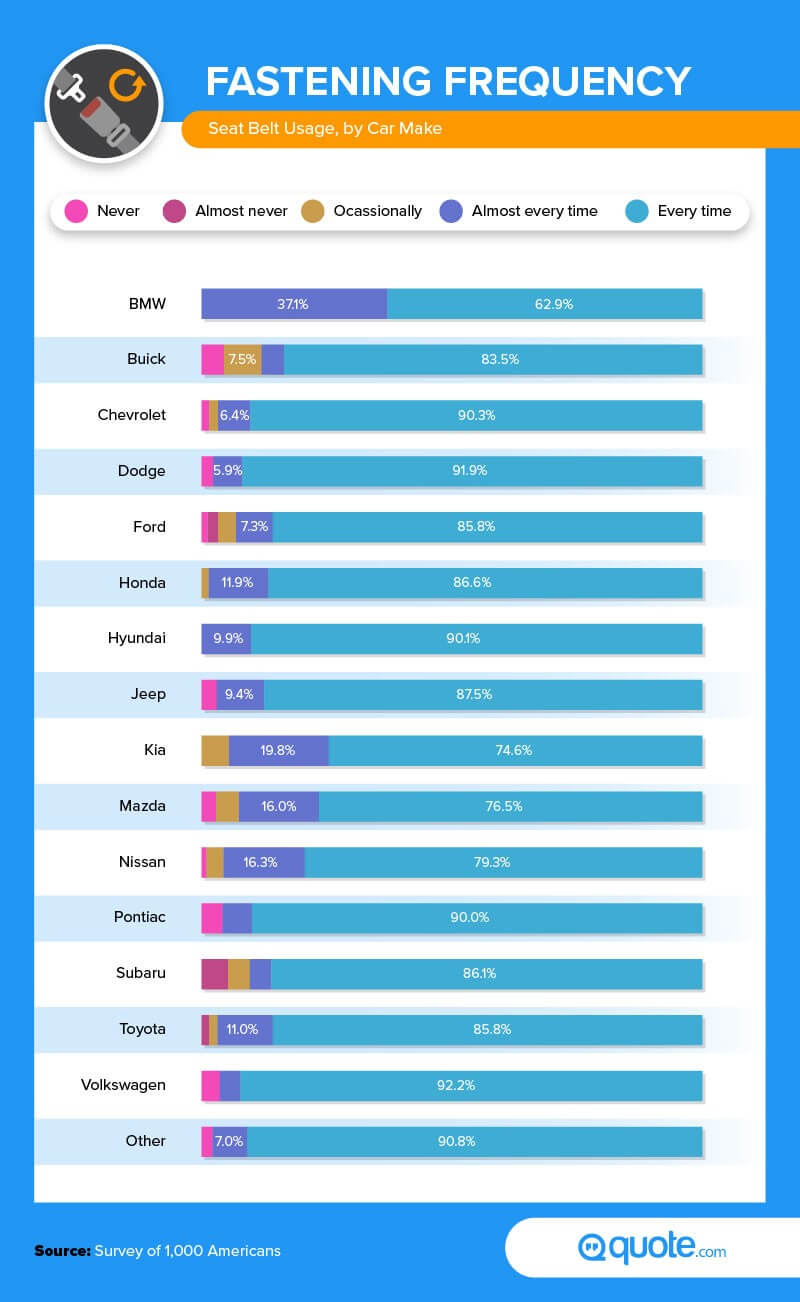
Our data also presented significant disparities in seat belt tendencies among drivers of different kinds of cars.
While at least three-quarters of all the other manufacturers' customers buckled up every time, some of Asia's most powerful automotive brands saw relatively low figures. Fewer than 80 percent of Kia, Mazda, and Nissan drivers used a seat belt every time.
Owners of American-made vehicles had commendable rates of buckling up every time, however, with roughly 9 in 10 Chevy, Dodge, and Pontiac owners doing so. But the brand with the most seat belt conscious drivers was Volkswagen, boasting a 92 percent record for buckling up every time. The manufacturer may be responding to its safety-oriented audience of late, earning the IIHS Top Safety pick designation for its 2018 Volkswagen Atlas.
Insisting on Safety
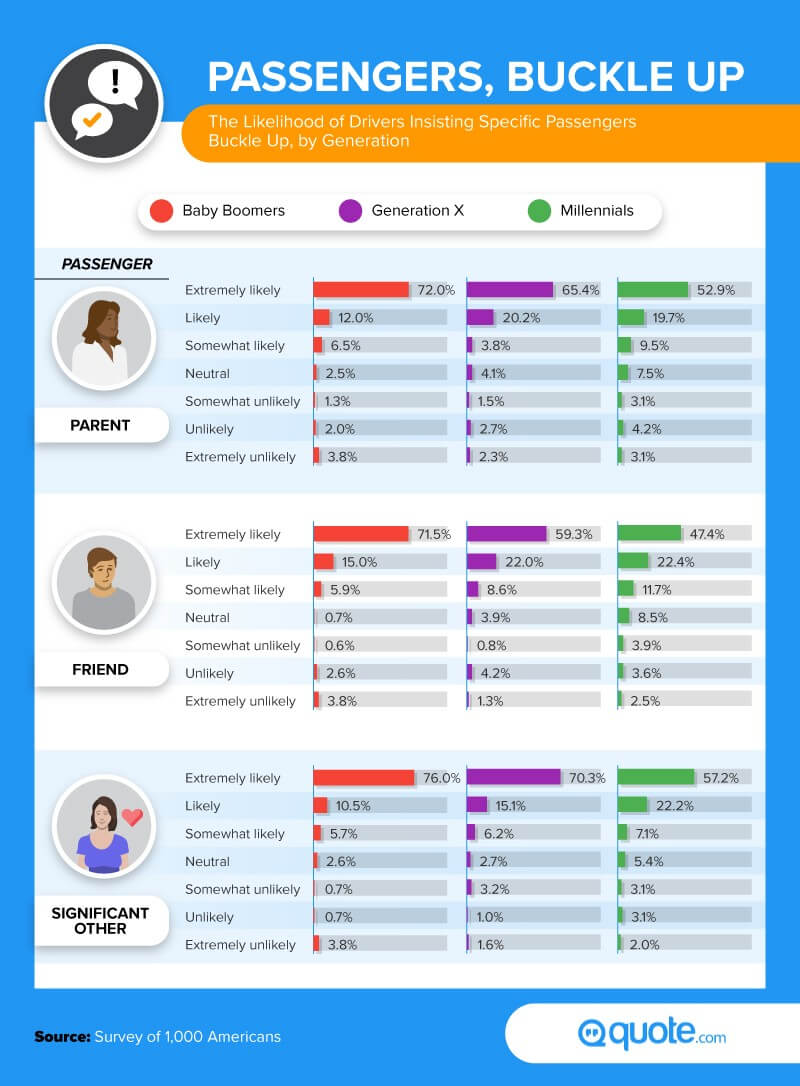
Among all generations, respondents most often said they were “extremely likely” to tell a significant other to buckle up. Parents elicited the second highest rate of “extremely likely” responses, whereas fewer were likely to say something to a friend.
Millennials were significantly less insistent about seat belt use than older respondents in each scenario. This resonates with our earlier findings that millennials are also less likely to wear seat belts whenever behind the wheel – it's unlikely you'll insist your passenger buckle up if you neglect to do so yourself.
These findings might concern public health officials, who have long sought to use positive peer pressure from responsible friends to influence the driving safety of young Americans. If millennial drivers are relatively unlikely to insist their peers and loved ones buckle up, we can only hope their perspective changes as they age.
Click It or Ticket?
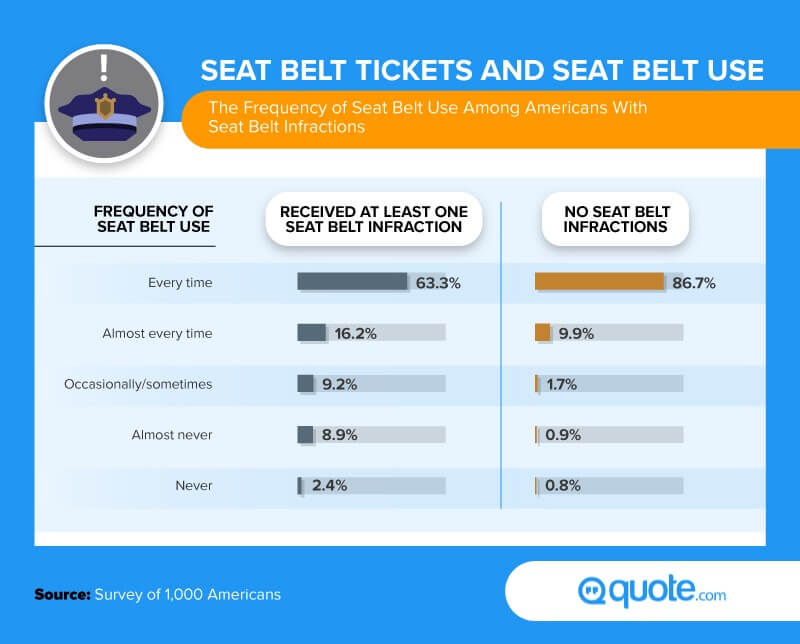
Unfortunately, law enforcement action doesn't seem to be particularly persuasive in convincing drivers to use seat belts more often.
Among those who had been ticketed for failing to wear a seat belt before, the percentage of those who always buckled up was still dramatically lower than the group that had never been cited. The percentage of those who never or almost never wore a seat belt was also higher among the ticketed group, suggesting some drivers' habits are impervious to regulation.
Perhaps the penalties applied to first-time seat belt offenders aren't large enough to serve as an effective deterrent. According to a Governors Highway Safety Association review of state statutes, the associated fine is often just $25 or less. As many people advocate for harsher penalties for other dangerous road behaviors, such as distracted driving involving smartphone use, perhaps greater seat belt infraction fines will also be considered in the future.
Unsafe Excuses
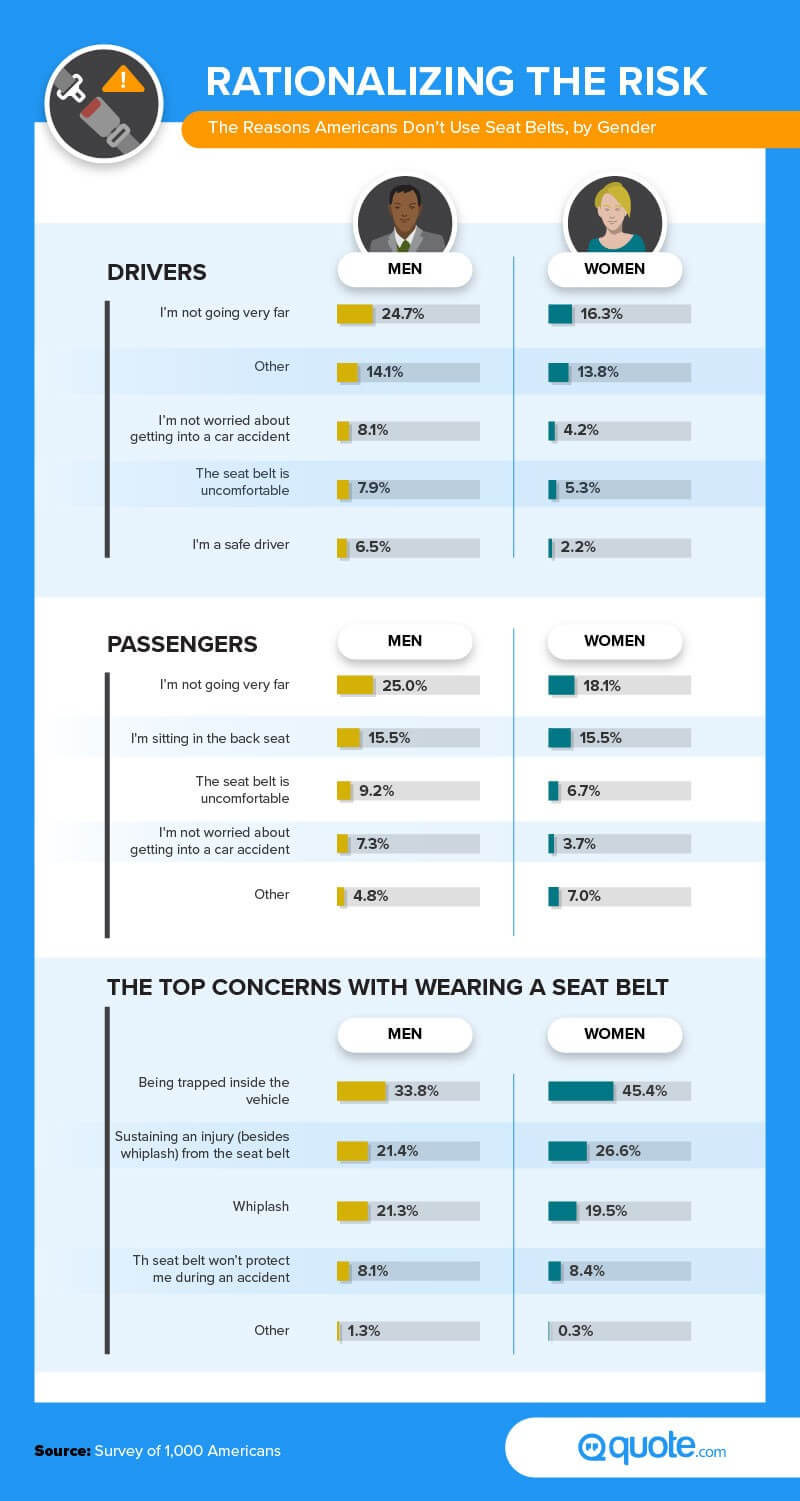
To better understand why drivers went without seat belts, we asked respondents about their motives for not buckling up. For both genders, as either a passenger or driver, the primary justification was the short length of their intended trip.
This response at least implies that participants understand the seat belt's safety value, even if they're mistaken about the minimal risk of short trips. Fewer people cited seat belt discomfort, although roughly 15 percent of passengers did say they felt they could go unbuckled in the back seat.
While relatively few people feared seat belts were dangerous, more than a third of men and over 45 percent of women expressed concerns about being trapped in the event of an accident. Other common justifications included fear of whiplash or some other injury caused by the seat belt specifically. While such seat belt injuries could occur, they're likely to prevent more serious outcomes, such as ejection from the vehicle.
The Price of Poor Protection
Our findings suggest the majority of American drivers are conscious of a seat belt's life-saving potential and use them accordingly. However, a relatively small pool of drivers continues to risk injury and death by ignoring this simple precaution, despite the well-established benefits of buckling up.
If you're among this group of seat belt skeptics, we hope our results encourage you to reconsider. And if you already wear a seat belt whenever you drive, keep up the habit in all circumstances.
Another essential aspect of protecting yourself on the road is great insurance, although finding the right coverage can seem a lot more complicated than remembering to strap yourself in. That's why Quote.com is here to help, guiding you to the insurance you need for the lowest price possible. Our no-cost quotes can save customers $500 or more on their annual premiums – keeping your wallet safe as well.
Methodology
We surveyed 1,000 Americans using Amazon's Mechanical Turk service. All results are weighted to be representative of the U.S. population based on age and gender.
Fair Use Statement
Feeling driven to share these results? Go for it, as long as it's for noncommercial purposes and you link back to this page and the author.
